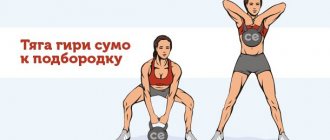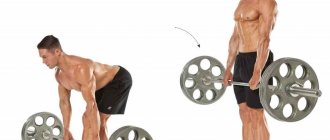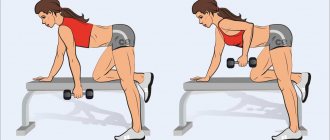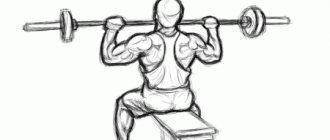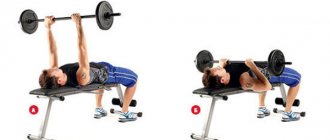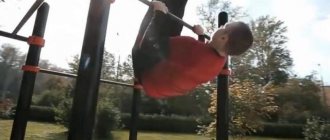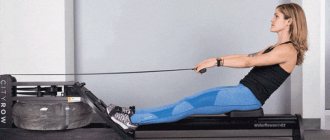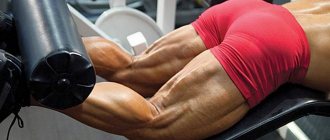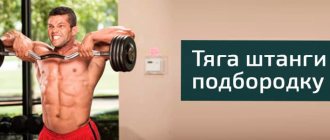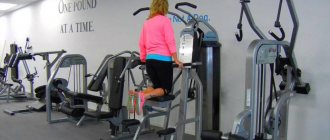The dumbbell row to the chin is a fairly rare exercise for developing the deltoid muscles, which is designed to work mostly the middle and anterior bundles. This row is suitable for those athletes who need to change their usual exercise to reduce muscle adaptation to the load, and it is also an excellent alternative to the barbell row for those who do not have the opportunity to exercise with a barbell, for example, in home training.
Advantages and disadvantages of pulling dumbbells to the chin
- The vertical dumbbell row seems like a simple exercise from the side, however, due to the lack of fixation of sports equipment, it is more difficult to perform.
- The exercise allows you to perform rows with one arm alternately, which is a more concentrated movement and relieves possible pain in the shoulder, elbow and wrist joints.
- Also, this type of deadlift can be performed with minimal weights, which is suitable for women and those athletes who are rehabilitating after an injury.
Errors in technology
In order for the exercise to give maximum effect and not cause harm to joints and ligaments, pay attention to the common mistakes that occur when performing it. This will help you control your movements and work on muscle development without the risk of injury:
- Do not point your elbows forward when lifting dumbbells. This is a traumatic position for the shoulder joints. The elbows move through the sides in a vertical plane.
- Keep your body straight throughout the entire movement, do not bend your neck or arch your back. Any deviations in body position from the correct one remove the load from the target muscles.
- Don't use too much weight, which will force you to break your technique. This will not give the desired effect, you will only waste your time.
Pulling with dumbbells is more gentle on the joints than the same exercise with a barbell. By performing it in combination with other exercises, you can get a beautiful outline of the muscles of the shoulder girdle, increase their volume and develop strength.
What muscles work when pulling dumbbells to the chin?
When performing dumbbell chin rows, the following muscles work:
- Middle, posterior and, to a lesser extent, anterior delta bundles.
- Upper part of the trapezius muscle.
In addition to the main muscles, are involved in the work .
If we compare the types of grip , then with a wide grip the load on the middle bundles increases, and on the front ones it decreases, in contrast to the narrow grip.
Adviсe
We recommend that you familiarize yourself with our recommendations, thanks to which you can make your shoulder training safer and more effective.
- If you have problems with your shoulders, then it is better to avoid doing this exercise.
- Don't forget about proper breathing. Unfortunately, this important component of the training process is not given as much attention as it should be. But in vain: due to improper breathing, your blood pressure may rise, which, in turn, will lead to a decrease in efficiency. Remember that you need to lift the dumbbells as you exhale, and lower them as you inhale. The same principle applies to other exercises: exhale in the positive zone, inhale in the negative zone.
- Be sure to warm up! The shoulder joints are very vulnerable, and therefore they should be stretched very well before starting training. Many beginners neglect warming up because they believe it is a waste of time and effort. Unfortunately, sooner or later this attitude leads to serious injuries, the treatment of which subsequently takes a lot of time and resources. By warming up, a person prepares his joints and tendons for subsequent loads, and this significantly reduces the risk of serious injury. It is worth adding that this applies not only to shoulder training, but to all training in general.
- Do the exercise very technically. Again, to be on the safe side, before adding dumbbell rows to your routine, study the technique of this movement in detail. It would be ideal if you ask a coach or some experienced athlete to watch you do it. If something happens, he will be able to help you and point out shortcomings that need to be worked on.
- If you are a beginner athlete, then it will be difficult for you to perform the stretching exercise with dumbbells. It is best to add it to your training program only after you have learned how to perform the same movement, but with a barbell.
Technique for rowing dumbbells to the chin with a wide grip
This option, thanks to the wide position of the arms, resembles raising dumbbells to the sides. An important point is the location of the elbow joints at the top point. At this moment, the elbow joints should be higher than the hands.
- The movement starts from the bottom. Palms with dumbbells are shoulder-width apart.
- The upward movement is performed with exhalation due to the tension of the deltoid muscles. It is very important to exclude jerks and sudden movements from the technique.
- At the top of the dumbbell row, pause briefly and then slowly lower the dumbbells down.
When pulling with a wide grip, the load is concentrated in the middle bundles of the deltoid muscles. Of course, it is impossible to exclude the work of the anterior bundles, like the rhomboid muscles and biceps.
Basic errors during execution
Too much weight
Many people think that the more weight they lift, the bigger their muscles will become. Of course there is a certain connection here. But they forget the most important detail. The weight you work with must be controlled. And if it is too big, then this is out of the question. And instead of big muscles, these athletes will end up with a shoulder injury. So work on your technique first. And only then, as your experience and muscles grow, the working weight increases. But do not forget that this exercise is isolated. Therefore, the burden will always be less than in the same SEATED DUMBBELL PRESS.
Round back during deadlift
Some people confuse a slight tilt of the body with a rounded back. To avoid this, I will try to explain this point. When bending forward, we keep our back straight and our shoulder blades apart. This is done to eliminate the trapezoid from the movement. This way we will only load the rear delts. If we work in a classical style, then our body should be in an even position. By doing this we reduce the pressure load on our spine. But as soon as we round our back, this load becomes uncontrollable. And can lead to displacement of intervertebral discs.
As you can see, the exercise is a bit difficult. But it is extremely effective when it comes to the development of deltas and trapezoids. Before you begin, it would be a good idea to study this material and work on your technique. Pay special attention to mistakes and do not make them. And then your training will bear fruit in the form of good results. And you will never know about injuries.
Good luck to everyone in your training!
Technique for rowing dumbbells to the chin with a narrow grip
Close-grip dumbbell rows are performed as follows:
- The athlete takes the starting position, straightening his back and legs, straightening his shoulders. The dumbbells are connected to each other by weighted discs on the hips.
- Before starting the movement, the athlete inhales and exhales during the upward movement.
- Dumbbell rows are performed in a concentrated manner by tightening the deltoid muscles.
- The peak of the movement is at the level of the collarbones. At the top point of the amplitude, the optimal solution would be a second pause, after which the arms with the weight slowly lower down to the starting position.
What weight should I choose?
Correct technique is, of course, important, but equally important is the weight of the equipment that the athlete uses to perform the dumbbell pull-down. Trying to achieve the desired results as quickly as possible, many athletes forget about safety precautions and take very heavy dumbbells, which subsequently seriously harms their shoulder joints. To prevent this from happening, try to choose a weight of shells that will not require you to swing your body. The torso should always remain motionless. On top of that, do not rush to use too heavy equipment, since this exercise requires the development of technique and precision of movements.
Technique for rowing one dumbbell to the chin
If an athlete feels discomfort in the joints, the exercise should be replaced with another or performed with one dumbbell in support.
The one-handed technique is as follows:
- Having fixed the position of the body, grasping the crossover handle with your free hand, for example, and placing your feet shoulder-width apart, we begin to move the dumbbell up to the chin.
- The dumbbell moves along the body at shoulder level.
- The highest point of amplitude in this version of the exercise can reach the level of the chin.
How to replace the exercise
The standing stretch has many modifications. The most famous is the barbell chin row or a similar movement in the Smith machine.
It is also performed on the lower block, using different types of handles (straight, curved, rope).
A rarer option is to pull a dumbbell to the chin with one hand. An interesting modification of the exercise that allows you to better focus on the muscles being pumped.
As for working the shoulders with other exercises, the “base” is more suitable here. First of all, these are chest presses while standing or sitting.
In this case, the emphasis is on pumping the same muscle bundles of the deltas as when pulling to the chin - the front and middle.
A military bench press with a barbell or a seated press in a Smith machine, a push push from the arsenal of weightlifting and CrossFit, and a standing kettlebell press (both with two hands and one) are also suitable.
Recommendations for Implementing Vertical Chin Rows with Dumbbells
- The exercise should be performed second after the basic vertical dumbbell press, barbell press or Smith machine press.
- I would like to note that when performing deadlifts using the techniques described above, the sports equipment stops at the level of the collarbones.
- For men , a classic training scheme is suitable, in which the athlete performs four sets of 8-12 repetitions and one warm-up set with 12-15 repetitions.
- For women, this exercise can be performed solo or included in a super set. It will be quite enough to perform 2-3 sets of 15-25 repetitions, depending on the training goal and physical fitness.
Frequent and common mistakes
When performing the exercise, it is important to follow a number of rules that will help not only get the maximum result from it, but also avoid various types of injuries. Let's look at them in more detail:
- Bringing the barbell to your chin. Don't take the exercise too literally. There is no need to pull the weight exactly to this level. After passing the chest, the forearms will be included in the work. In addition, each trainee has his own range of motion. To determine it, you need to feel the muscles well. But, as a rule, for most the highest point is the level of the chest or collarbone. This is the place you need to pull towards.
- Using too much weight. The biomechanics of the movement is that when lifting the weight upward, the scapula puts pressure on the capsule of the shoulder joint. When working with heavy weight, the shoulder cuff may fail and become injured. As a result, the trainee will be limited to exercises for the deltoid muscles.
- Neglecting warm-up. Although the exercise is performed in the middle of the workout, it is still necessary to perform 1-2 warm-up approaches so as not to injure the shoulder joint. Due to his mobility, he is most susceptible to injury. Therefore, you shouldn’t be lazy, spend a little time and not immediately reach your working weight.
- Properly include in the training plan. Some people are one of the first to start doing this exercise, thereby spending too much effort and energy on it. By the time the trainee moves on to basic presses, the muscles will already be slightly tired and the effectiveness of such exercises will decrease. Therefore, it is more advisable to perform chin pulls in the middle or towards the end of the workout.
- Violation of performance technique. The problem is that many people move the bar away from the body. Because of this, the load falls on the hands. However, the correct thing to do is to keep it as close to the body as possible so that it slides over it. Only then will the shoulders take part in the work, and not other muscles.
- Incorrect body position. In all exercises with a vertical load, the back should be straight. This takes the load off her and does not injure the vertebrae.
- Eversion of the hands. Try to keep your hands straight, otherwise this increases the load of the weight of the barbell on them. As a result, this may interfere with concentration while performing the exercise.
- Don't cheat with your body and arms. This is not an exercise in which you need to “finish off” the remaining repetitions with all your might. Because it's absolutely useless. It’s better to take less weight, but do everything as technically as possible.
- Use dumbbells. They allow you to increase the amplitude, in addition, they are considered a more “gentle” option for the shoulder joint.
Video tutorial
It seems to us that just a photo of a stretch with dumbbells and a text description of this exercise will not be enough to fully understand how to do this movement. To learn the material, we advise you to watch the video tutorial, which shows in detail the technique and nuances of broaching.
We think that we can put an end to this. We hope that the information presented in this publication was interesting to you. Use it in practice and then you will succeed in pumping up big shoulders!
Safety
All injuries and joint problems can be easily prevented with the correct technique. It is very important to choose the right dumbbells for yourself. Experts do not advise novice athletes to lift too much weight, as they are unlikely to be able to complete the approach to the end. It is better to take lighter dumbbells and perform them correctly than to take heavier ones and not complete the exercise.
To protect your back from damage, it is advisable not to move your body and back . This not only reduces the effectiveness of the exercise itself, but can also cause painful strain in your back muscles. While pulling the weight towards your chin, you need to stand straight, without hunching or slouching.
Elbow joints tolerate large point loads very poorly. Because of this, the stretching is performed with slightly bent arms. This makes it possible to reduce the workload directed to the elbows.
Anatomy and features
All muscles in the body can be divided into two large groups: pulling and pushing. For example, the pectoral muscles are pushers, and the back muscles are pullers. It all depends on the force vector and the attachment features of the muscle itself. Our shoulder joint is unique in that it combines both muscle groups; with the help of our deltoids we can both push and pull. All this gives the shoulder joint super mobility and mega functionality, because it is involved in almost all movements of our hands. But you have to pay for everything, and for such excellent mobility you have to pay with extreme fragility. The most common injury among bodybuilders is, as you know, a shoulder injury. But let’s not talk about sad things, especially if you approach everything headlong, there will be significantly fewer problems.
It is traditionally believed that the deltoid muscle consists of three bundles: anterior, middle and posterior. In most sources you can find information that to develop the front and middle deltoids you need to perform pressing movements, and for the rear - pulling movements. But this division is very arbitrary and questionable, since it is very difficult to involve the bundles separately using basic exercises. Of course, this can be achieved with some isolated exercises, but again the question of their effectiveness compared to basic exercises remains open. So it is more correct to divide the delta not into three, but into two bundles or hemispheres, the front half performs a pushing function, and the back half performs a pulling function.
